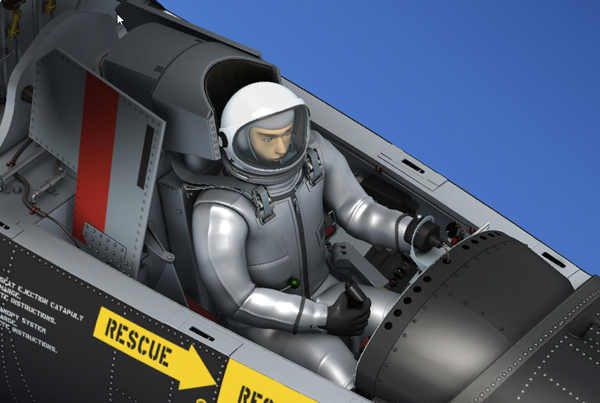
X-15 pilot. Note the integrated harness which is part of the pressure suit.
On the real aircraft, the personal parachute for the pilot is contained within a fiber glass parachute container [3, fig. 4-2] that is attached to the pilot's integrated harness at the top and bottom.
The parachute may be either a 24-foot or a 28-foot type. Another fiber glass container [2, fig. 4-2] contains the pilot chute and, along with the parachute container lids, closes the top of the parachute container. The pilot chute container is held in place by a retaining pin that locks into the manual ripcord pin. On the top of the container, a retainer pin fits into the ejection seat headrest [1, fig. 4-2]. During ejection, the pilot chute container is locked to the headrest as the seat leaves the airplane, and is pulled off the parachute container to deploy the pilot chute when the headrest is fired. This in turn pulls out the main parachute canopy.
A rescue beacon transmitter, installed in the parachute container, is automatically energized into continuous operation when the pilot's parachute deploys. The transmitter antenna is attached to one of the parachute straps. Transmission is on the X-15 telemetering frequency of 244.3 megacycles. The transmitter permits ground stations to obtain position fixes on the pilot after an ejection.
Note: The canopy and the seat cannot be ejected in this software version. Animating and programming the complex ejection method used on the X-15 airplane, including modeling the parachutes, was beyond the scope of this project.
The parachute container is attached to the seat by a strap on the lower corner of each side. This strap is attached to a fitting which is held by a lap belt release on each side in the seat bucket. This release hinges on a pip pin [11, fig. 4-2] during automatic release, but can be removed manually to permit removal of the parachute container without actuating the restraint release system. When pilot-seat separation occurs during ejection, the parachute container remains with the pilot.
The parachute riser [5, fig. 4-2] quick-release buckles also fasten the shoulder harness and parachute container to the pressure suit fittings, on the pilot's chest, just below the shoulders. The rip cord "D" ring is attached to a strap fastened to the left side of the parachute container. This strap also has a quick-release buckle which is fastened to a fitting on the left side of the integrated restraint harness, just below the arm.
The lap belt portion of the integrated restraint harness consists of two straps, one over each hip, fitted with hooks that are snapped into a ring portion of the lap belt release fitting on either side of the seat. The lap belt has double adjuster straps, one through each side of the buckle. The adjuster straps must be pulled tight to keep the pilot firmly in the seat. This attaches the pilot to the seat and parachute container.
The full pressure suit was modified for the X-15 airplane and has the restraint straps and parachute harness designed as an integral part of the suit. A neck seal is used to keep the suit pressurization nitrogen and breathing oxygen separated.
Attached to the back of the restraint harness is a controller back pan which incorporates an oxygen regulator, suit pressure regulator, anti-G valve, and the emergency oxygen supply for breathing and suit emergency pressurization. This emergency oxygen supply is sufficient for about 20 minutes after the pilot separates from the ejection seat. On some pressure suits, the oxygen and communication lines from the controller back pan are internal and plug into a pressure suit mating receptacle over the left shoulder blade. In other types of suits, they connect to the helmet. The personal-lead disconnect block is also attached to the controller back pan. The suit regulator ventilation exhaust valve is over the right shoulder blade (controls are also provided on some helmets).
The emergency oxygen supply in the controller back pan is actuated automatically when the seat ejection handles [10, fig. 4-2] are raised, or can be actuated manually by a green ball on the right side of the suit. The helmet is free-rotating and is fastened to the suit with a snap connector ring that seals the joint. The helmet visor is locked down with a squeeze latch on the bottom edge.
When the visor is down and latched, the suit and helmet are completely sealed in a leak-proof unit. The visor is kept fog-free by the breathing oxygen as it comes in around the face opening and across the visor.
See also: